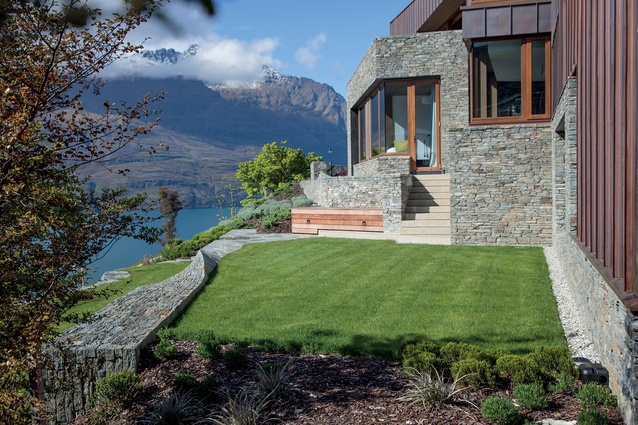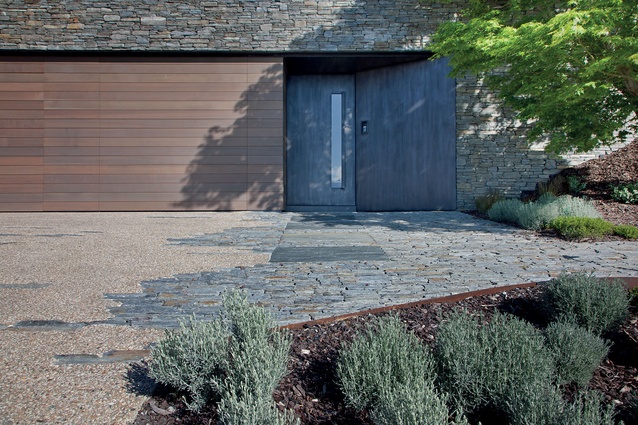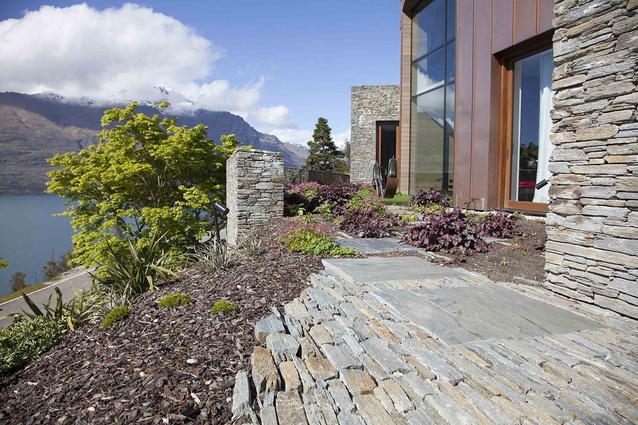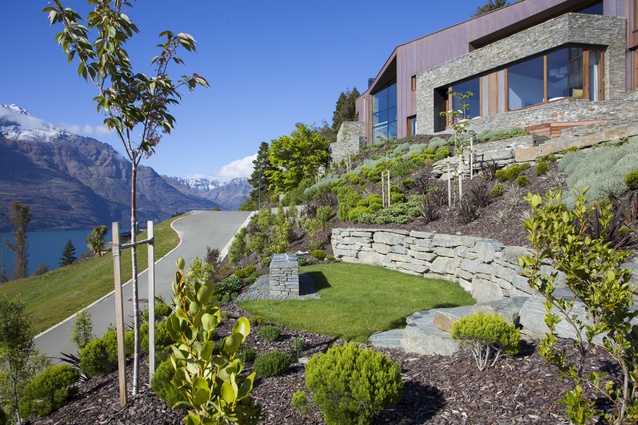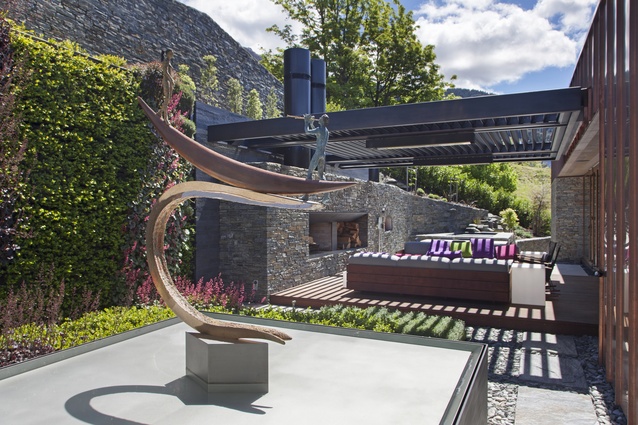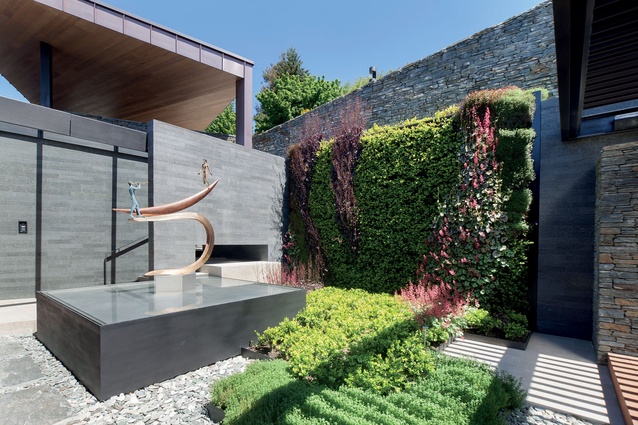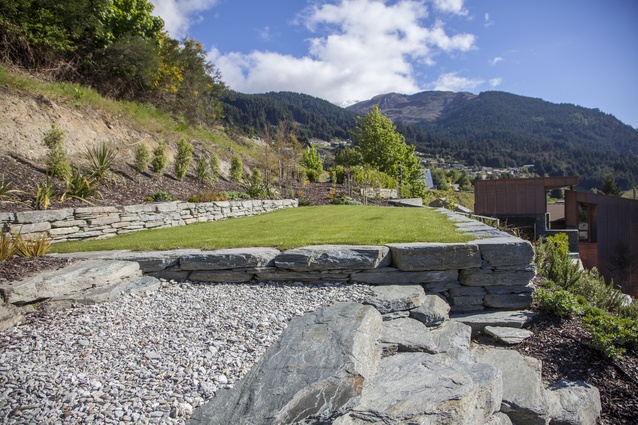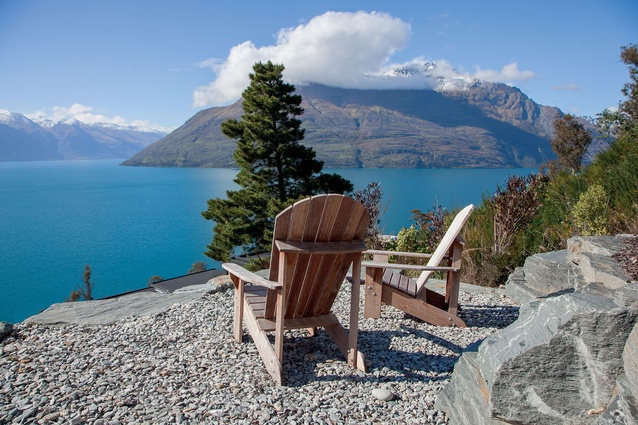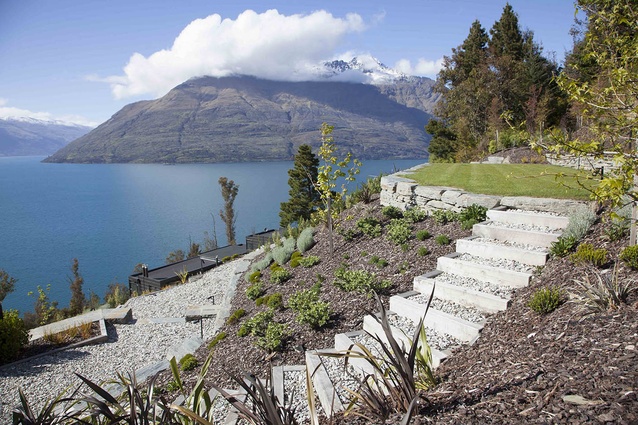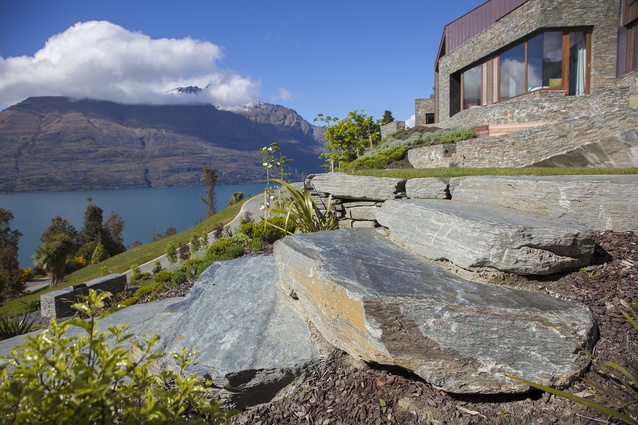Copper house
The house itself is a sight to behold. Set on a steep site in the Queenstown suburb of Aspen Grove, its sizeable form rises dramatically from the hillside. Copper tray roofing wraps around various planes, both horizontal and vertical, folding down and around the front elevation. Broken by schist detailing, the façade makes a bold statement, due in part to its scale.
But it is the extensive, intricate landscaping that grounds this structure in its stunning surroundings – due to its siting high above Queenstown it has sweeping, unobscured lake and mountain views.
From the street below the house, it is clear that the landscaping, extending over the main section upon which the house is sited and an adjoining one as steep as the first, is derived from a concept set well apart from the regional vernacular. While it takes its cues from the rocky mountains in which it is set, there is far more to this landscaping than the jagged peaks of the surrounding ranges.
Landscape architects Jo Dey and Rebecca Lucas of Queenstown-based LAND Landscape Architects, were involved from the inception of the project nearly five years ago and worked closely with the architects and clients to develop the concept for the 2500m2 residential setting. The aim from the outset was to create a memorable garden setting when viewed both from within the building, and from outside, which complemented the stunning surrounds and the unique architectural design and scale of the house.
“On a functional level, the clients wished for privacy, for colour within the planting, and to tame what was essentially a very steep site into interesting and useable areas,” Dey says. “The house used large areas of locally-sourced schist stone wrapping into the facades and then stepping out into the landscape beyond. We took those principles into the landscaping by repeating the schist stone on a variety of planes, both horizontally and vertically.”
Schist is a significant feature of the region and forms the craggy tops of the mountain ranges that dominate the views from the site: these rock formations were pushed up through geological processes over millions of years, resulting in the schist pushing and twisting, changing their orientation from horizontal to vertical and anything inbetween. “We wanted to replicate this but in a formal setting, which related it to the house,” Dey says. “So we included, in three areas in the garden, walls that twist through 90 degrees, twisting the vertical faces up until they become horizontal, taking the facing of the wall and using it to form the paving surface material. The stone walls therefore extend the folding planes of the house into the landscape and connect the house to the hillside.
“Drifts of both native and exotic planting wrap around the schist walls and steps anchoring these hard landscape features back to the ground plane. Taller growing evergreen trees and shrubs offer privacy and screening from residential neighbours. A mature Japanese maple tree was craned into place at the front entry to the house and has created a beautiful entry with dappled shade falling across the stone façade of the house providing a feeling of maturity to the project far beyond its actual age.”
Because of the steep incline of the site, walls became a dominant and necessary part of the landscape concept in order to create terracing and useable spaces. In addition to the twisted walls, a green wall extends the length of a three-metre-high retaining wall at the rear of the property offering a unique persepctive to the home’s entertaining courtyard and incorporating the principle of utilising a traditionally horizontal medium on a vertical face.
Here, at the rear of the house, schist walls also provide a focal point. “A sculptural element was blending and overlapping the traditional and ordered schist-faced stone walls with the more relaxed and tumble-down schist boulder walls, which also performed a retaining function.” The boulder walls step out into planted areas, offering a more organic transition.
A large transplanted Japanese maple marks the main entrance to the house; to the right, the first of the three twisted walls is visible from the road. “Drifts of ornamental planting feature here, with horizontal schist stepping stones set within vertical schist on edge. This vertical schist then blends back in to form the twist of the most accessible twisted wall. It twists to become horizontal and form the front face of the retaining wall to the east.” The path up from the lowest lawn and seating area near the entrance winds across the property on digger-placed boulders and then along the base of the main twisted wall.
Set in between two grassed areas, the main twisted wall offers a stunning standalone sculptural element in the grounds, which is accessible from all directions. When viewed from the bedroom directly behind, it provides the foreground to views of Lake Wakatipu and the Remarkables. A ‘pause’ is set into the end of the wall – a place to sit and contemplate the mountain vistas.
Dey says one of the biggest challenges of this project was transforming the concept of the twisted walls into reality. To do so required close work with with the project engineer, the builders and the stonemasons to preserve the purity of its design aesthetic with the practicality of the how the twist needed to be constructed to be self-supporting.
Another challenge was the steep terrain, which made access difficult. The soil was unstable due to the steep slope and the amount of existing rock. “Steep slopes of disturbed ground were stabilised using a Maccaferri product called Geoweb.” This helped keep soil and mulch in place and meant planting could be instigated between the material’s cells. The design and layout sought to work with the existing contours wherever possible, with surface rock at the top of the site utilised to create informal paths and steps.
The adjoining section features a croquet lawn at the highest elevation. Seating areas and sculptures are dotted across the section, while extensive planting offerw swathes of colour.
Native plants were utilised as the structure for the landscaping to provide textural interest – including hebe species, black and green flax and astelia. Red beech trees and broadleaf hedges were used to screen the property from neighbours and the road, and a mix of evergreen native and exotic shurbs were used as a backdrop for drifts of smaller, more ornamental plants.
While the planting is not yet mature, the concept is clear and already offers a stunning visual counter to the copper-clad house and place to muse the immediate and extended surrounds. “We wanted the experience of walking through the garden to be one of interest and wonder, both at items in the foreground and in the background,” Dey says.


